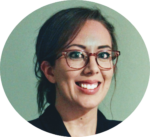WANT TO BE A NEW CHAPTER ALUMNI?
Apply online to share your accomplishments and endeavors.
APPLY TO BE FEATUREDDecember 2025

Aurora, Colorado
Postdoctoral fellow Department of Craniofacial Biology
University of Colorado Anschutz Medical Campus
VIEW PROFILELomeli Carpio Shull, Ph.D. (BMB ’16), says she’s always been interested in understanding goings-on in the human body — an interest spurred by “The Magic School Bus: Inside the Human Body” and advanced during a Summer Undergraduate Research Fellowship (SURF) and then graduate school at Mayo Clinic. Now Dr. Shull is at the University of Colorado doing basic research to understand development of the craniofacial skeleton and better understand how congenital defects such as cleft palate occur.
“When beginning your training, find a mentor who really supports you, is your advocate and pushes for you to succeed. Dr. Westendorf was a great advocate for me and my success. She’s very approachable, and her door is always open.”
I’ve always had an interest in understanding what’s going on in the human body. Growing up, I loved “The Magic School Bus: Inside the Human Body,” which led me to consider becoming a physician. During college, I was accepted into Mayo Clinic’s Summer Undergraduate Research Fellowship (SURF) Program, which kicked off my interest in biomedical research. I was fascinated by basic biology experiments and discovering new things.
As a SURF student, I experienced the Mayo Clinic environment and wanted to pursue graduate school there. Mayo Clinic Graduate School of Biomedical Sciences has top scientists and resources. I had a fantastic mentor in Jennifer Westendorf, Ph.D. (IMM ’96), who trained me to become a good scientist; and a supportive committee that helped me establish myself in the scientific world. My thesis focused on understanding the gene regulatory aspect of long bone development and an epigenetic factor that globally regulates gene expression patterns during skeleton development.
I was in awe and star-struck as I stood in front of the statue of the Mayo brothers. Mayo Clinic is a leading institution for medical treatment, patient health and research. That combination fascinates me.
Through my mentor, I learned to think critically — knowing what to do you’re faced with a problem you can’t figure out including how to troubleshoot to solve the problem or go around it with an alternate approach.
On a larger scale, Mayo Clinic instills in its students, trainees and faculty that the patient comes first. As a basic scientist, you don’t interact with patients. But I learned to still put the patient first, knowing my efforts will help patients eventually.
When people know I got my Ph.D. at Mayo Clinic, they’re often wowed. They know it means I have a strong foundation.
I am a postdoctoral fellow under the guidance of Kristin Artinger, Ph.D., at Anschutz Medical Campus. I continue to use basic science to understand the principles that allow for proper development of the craniofacial skeleton. I combine different animal models, zebrafish and mice to see how the processes are conserved across vertebrates so we can better understand the signaling pathways in humans. Many of the animal models and genes we mutate have recapitulating craniofacial abnormalities. We have a mouse model that develops a cleft palate when a particular gene regulator is lost. This helps us understand how that condition arises and the role that key regulatory factor plays in proper development of the craniofacial skeleton.
I’m also collaborating on a project that found a mutation in patients who have split hand-foot malformation. In a zebrafish model, if you mutate the same gene found in a human family with the mutation, the zebrafish develop a similar malformation in their fins. We’ve shown that the same pathway can cause similar phenotypes across species.
I recently received a three-year fellowship award from the National Institute of Dental and Craniofacial Research to further my research.
I’m proud of my first-author paper during grad school. It was published in Science Signaling and essentially encompassed my entire thesis research. I was happy with how the project turned out and that we got it into a higher journal.
I’d like to develop my own independent research program and run my own lab, training graduate and undergraduate students. I’d like to remain in craniofacial field, and understand how specific gene programs are controlled during critical development processes.
When beginning your training, find a mentor who really supports you, is your advocate and pushes for you to succeed. Dr. Westendorf was a great advocate for me and my success. She’s very approachable, and her door is always open.
I like running. I’m in Colorado now, so great outdoor activities are close by. I like bingeing on TV shows like “Game of Thrones.”
I like to bake cakes and make intricate designs on them. A grad student in my lab was defending her qualifying exam. She’s studying fish fin development, so I decorated a cake with fish fins. I also decorated a cake with Danny Devito’s face. I think the experimental nature of my work comes into play in my cake decorating.
See past New Chapter stories here.
Apply online to share your accomplishments and endeavors.
APPLY TO BE FEATURED